I know where I’m going. To reach the hospital my dad is in I need to catch the 97 bus eastwards in the direction of Chelmsley Wood: a bus which runs every four minutes and which, like most buses in Birmingham, take people from the centre, where the city misspends its money, out to the places where it should be spent. What hasn’t been rebuilt is tatty and what has been rebuilt is shoddy. Before I leave New Street concourse I call the consultant, who’s given me his pager number to ring, and tell him I’ll be 20 minutes depending on the bus.
Some people leave and never go back. By contrast, I seem condemned to find myself on the 97 bus, out to the terminus and back, out and back again, for eternity. The house I grew up in was at the final stop, where the road meets the motorway. My dad, fittingly, is in hospital halfway along the route – half the way from home, half his way towards the city centre pubs he spends most of his time in.
The driver pulls in just beyond the shelter, rests a few minutes with a copy of the Metro, and adjusts his wing mirrors before turning around and opening the doors to let us on. For the next 50 minutes, the bus will crawl, more or less in a straight line, for nine miles out of the city, but for now, the journey commences by getting stuck at the lights outside Digbeth Coach Station. The bus sighs and judders, its passengers sighing in sympathy, as it lets through a chain of National Express coaches setting out to all the places from which people struggle to make their way: Skegness, Doncaster, Sunderland, Birkenhead; Hull, Wrexham, Dundee.
Birmingham is an interchange: it sits in the middle – an “ignored void at the heart of the country” according to the critic and filmmaker Jonathan Meades – rather than in the centre of things. Its most famous landmark is not a beautiful building, but Spaghetti Junction, an eyewatering tangle of express roads designed to enable people in cars to avoid the city centre on their way to other places.
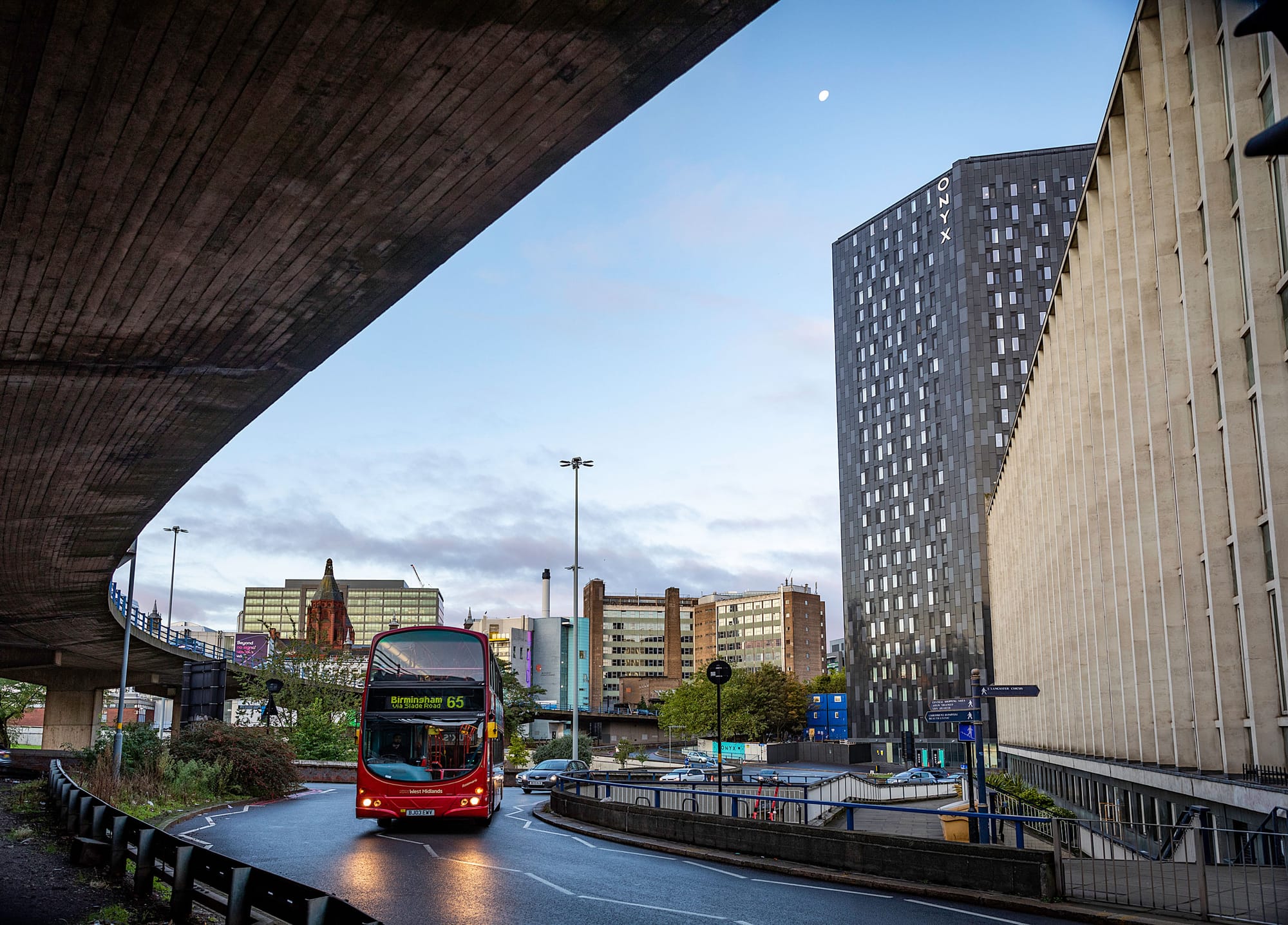
By contrast, any traffic trying to leave the city centre has its work cut out. At Digbeth, the 97 turns left next to a pub, The Old Crown, that has stood since the 14th century. On the top deck, numbed people from all corners of the world clutch half-litre cans of Monster and wriggle bitty content out of their phones. We pass boxing gyms and Lidls, a drive-thru carbs emporium called Big Johns, Birmingham City Football Club, a naval college converted into a mosque, and a rusted piece of 1980s public art, before it attempts to squeeze through narrow thoroughfares never intended for modern-day Birmingham traffic.
There are BMWs parked on both sides of the two-lane street, spliced in with white vans and minicabs. People try to cross the road, halfway between two sets of pedestrian crossings, by waving distractedly at approaching vehicles, while our bus, never made for such a scene, gets jammed like paper in a printer. There is nowhere else for it to go. The previously silent, sullen top-deck passengers start swearing out of the window, and my teeth start to grind in anticipation of the racial tension that was an inevitable feature of this journey while I was growing up. An urban bus trip of this length has phases; spatial sections that play out, each with their own scripts, whenever it’s made. On the way into town there would be a sudden shift at the point where the streets and houses became infinitely more cramped and the faces more varied. The change in mood would be perceptible enough for me to feel a bodily clenching for the last ten minutes of every trip. Sometimes younger men would square up to each other at the squeeze point between the driver’s cab and the seats, impossible to pass through without invading other people’s personal space. White pensioners would suddenly start to grumble and turn to whoever was sitting next to them, anticipating an exchange of performative tutting.
Once bus routes were opened to competition in the mid-1980s, you would get streams of racing buses – sometimes just a bloke in a clapped-out minibus – collecting fares along the 97 route by overtaking the regular services and racing each other into town at full pelt. One dark, wet Saturday evening in November 2001, short of cash, I jumped on one of these in town as it was 20p cheaper and I thought it would get me back quicker. (Moor Street to Chelmsley Wood on an old minibus in the cold, dark and rain: there was something inherently self-punishing about my determination to make this journey in thisway. Mind you, I can’t drive, and taking a nine-mile taxi journey in those pre-Uber days seemed profligate, so I didn’t have much choice but to pay a quid and suck it up. But if you are going to choose to return, do it willingly, do it kindly, not as if you are being subjected to divine retribution.)
Several of us piled on to this bus and moved towards the back; five of us strangers sat in a row chatting merrily about how Bonfire Night means Christmas is next. The older woman next to me seemed particularly sweet, taking delight in the small children sitting next to her and asking them what presents they were hoping for. As she chatted, two young Asian women in floral headscarves got on and sat in the seats nearest the driver.
A beat was missed.
“Here come the terrorists,” said the woman, nodding judiciously.
Always at this point on the journey I remember – not that I ever really forget – why I ran for my life away from this fate, and why I am pathetically grateful that I did.
Eventually, the knot of traffic resolves itself and the 97 double-decker creeps on, as far as the huge 1930s pub that was converted into a McDonald’s just before I left home in 1994. The narrow street splays out into an expansive dual carriageway, marking the point at which Birmingham spread east in one of the city’s successive concentric circles of growth. From here it will move through the 1930s ring, the 1940s, the 1950s, and finally to its late 1960s terminus – each time the roads widening, the houses changing, the centre of the city becoming more distant.
Every journey taken leaves its residue. At every point you pass there’s an image, a sensation, pleasant or otherwise, associated with it, to the extent that you know you would half-disappear if that route, that possibility, were removed or obliterated. I imagine the journey taken by my great-grandparents, who moved from Ladywood in the city centre to Lea Village two or three miles away: a new, curly-mapped settlement of council homes on this route in the early 1930s. They got around by trolleybus and bike, my grandad cycling out to Chelmsley Wood when it still was a picnic spot. I wonder what went through his mind when he learned that the picnic spot – a cherished bluebell wood – was going to be flattened by 18,000 houses. Did he ever try to find the paths he used to take? Was he able to trace them in his mind? Chelmsley Wood was built on a significant fragment of the historic Forest of Arden; it is bordered by the M6 and M42 on one side and Birmingham Airport on the other, where the city was permitted to sprawl into the Warwickshire green belt. As a child, I never once thought about bluebells, or what stood under my house or my grandparents’ house, but now it’s all I can think of.
Another mile or two further out, we pass the gaping hole that once housed the shopping centre where I got my first job at a branch of Greggs when I was 16. I remember feeling that having my own cash put me on a par with royalty, surreptitiously checking my £10.02 wages at the bus stop going home every Saturday and seeing if I could wolf a whole custard slice before the bus showed up. The wide Meadway drops and climbs here like a big dipper, swooping down at Stechford junction where it meets the number 11 – the Outer Circle, notable for being the world’s longest bus route. (The number 50, which runs from Birmingham city centre to the southern peripheries every two to three minutes, is touted by its operator, National Express, as the most frequent service in Europe.)
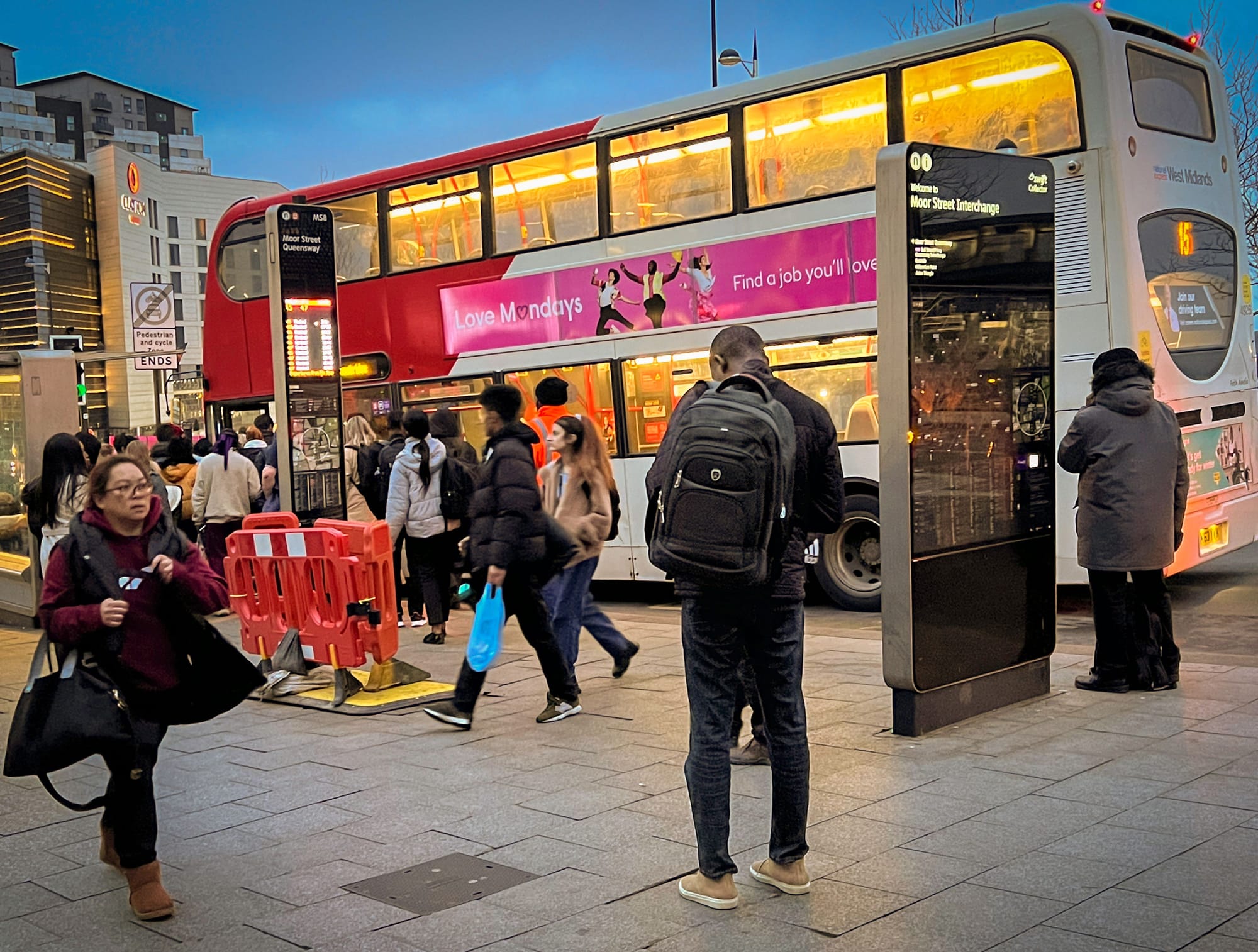
To say things like that makes it sound as though Birmingham is an easy place to get around, when in reality its population is choked by traffic. Birmingham is the ultimate case study for digging down into the confluence of social, technological and historical factors that go into making a city work well or work badly. In the 1950s and 1960s, the city was seduced by a transatlantic, rather than European, concept of urban glamour. Birmingham was going to become known not for the casual way you could amble through the city admiring its neo-classical architecture, but for how you could see it on the skyline as you raced past it in your car.
To the historian Simon Gunn, postwar Birmingham was “Britain’s premier motor city”, pummelled into its concrete corset by the city’s chief engineer, Herbert Manzoni, who believed that civil engineering could cure what he had once called the “cancer” of traffic congestion. Manzoni was prepared to bulldoze his way through the city in order to let motorists move freely, not anticipating that the more roads you build, the more cars you’ll get on them. Buses were an afterthought. An underground rail system was dismissed by Manzoni as “hopelessly uneconomic”, while trams were dismantled, near-simultaneously, in the mid-1950s by just about every town and city that had them.
Manzoni reshaped Birmingham around cars, which in turn shaped the lives of the people who lived there, for better or worse according to whether or not you had a car of your own. “In ten years,” he said, in 1959, “we are going to have one motor car per family. It is the aim of every family to own a motor car – and I would say the right in modern conditions of every family to own a motor car. Restriction is not the way. You have got to welcome the traffic. You have got to realise that it is an indication of a high and increasing standard of living.”
Needless to say, no one in my extended family ever owned a car, which has led to my lifelong obsession with buses. We weren’t practically locked out of the city by having to rely on buses, but in spirit we were, and so was any other Brummie who didn’t drive – who didn’t want to or, more likely, couldn’t afford to. Our relationship to the centre was defined by how much harder it was to leave the periphery.
You know you are – finally – three-quarters of the way home when you pass Richard Gilbert Scott’s striking 1967 church at Kitts Green, opposite which my mum spent most of her childhood in a now-demolished block of tenement flats. Seeing that church reminds me of the untold thousands of journeys on the 97 made by my parents – halting, sometimes nausea-inducing, endless-seeming – to and from work, for decades, to which, without question, I attribute my lifelong determination to avoid having a proper job. When I was a toddler they made the decision to move from a “starter home” – a glorified wendy house – near a train station to a slightly larger starter home on a council leasehold: cheaper, marginally bigger, but meaning my dad could now only get to work on the bus. My dad’s drudging commute, which would have taken a quarter of the time if there’d been a tram or fast train to take him to work, now took an hour. Twice a day for 15 years, with rigid, depressive discipline, he took this bus from one terminus to the other. You could deduce how well he was coping by how long he took to read a book on the daily journey, and that he wasn’t coping when he stopped taking a book at all. By the time he got transferred to an office in Sheldon, a mere 20-minute bus ride away, he was already halfway to being broken by it.
Birmingham was cruel to my parents: it contained rich resources that they struggled daily to access, for the simple reason that the city was not built with their needs and means in mind. They – we – were constantly told that Birmingham was the city of the future, when all the while they could barely make use of the present.
Reaching the hospital at East Meadway, I disembark at a tatty shelter pocked with cigarette burns, bordered by verges made of equal parts mud and empty Lucozade bottles. Bus shelters in Liverpool aren’t allowed to get this messed up: it’s a matter of civic pride. Shattered panels are replaced within a day, and are regularly repainted in cheery sunshine yellow, even if they do get splattered with takeaway rice. I cross the road at the traffic lights, an experience akin to taking part in Wacky Races, and register that the bus shelter on the other side of the road is in just as dire a condition.
Throughout the day the shelter fills with nurses and porters coming off shift, vaping and waiting tiredly around its edges, unable to see buses approaching through the scoured Perspex windows. Most will have to change waiting again, in the city centre for buses to other peripheries, alighting in the dark and having to do it all again the next day. When you are paid hourly, you aren’t paid for the hours you spend getting to and from work, no matter how long it takes, and you have to pay for the privilege of getting to work in a place that doesn’t pay you enough to live closer by. Low pay, inadequate housing and exhausting commutes are a vicious cycle to which no one should be subjected, but they work in tandem. Spend 12 hours working in a hospital or a care home every day, and you should be ferried to and from your home on a golden cloud, not cast out to dark bus stops in the rain.
Time and again I return to the geographer Doreen Massey’s observation that “much of life, even in the heart of the first world, consists of waiting in a bus shelter with your shopping for a bus that never comes”. What distinguishes bus travel from other forms of mobility is the fact that you can rarely guarantee exactly when a bus will show up. To drive, walk or cycle, you simply set off. To catch a train or plane, you consult the timetable and have a reasonable chance of setting off when you expect to. Buses and their drivers are themselves at the mercy of the circumstances in which they operate. Traffic doesn’t part for them. Passengers don’t always have the right change (which you have always needed in Birmingham in order to board), or will hold a bus up in order to complain that their bus was held up. You have to become inured to, or ground down by, the loss of control that such uncertainty involves if you are not to go mad.
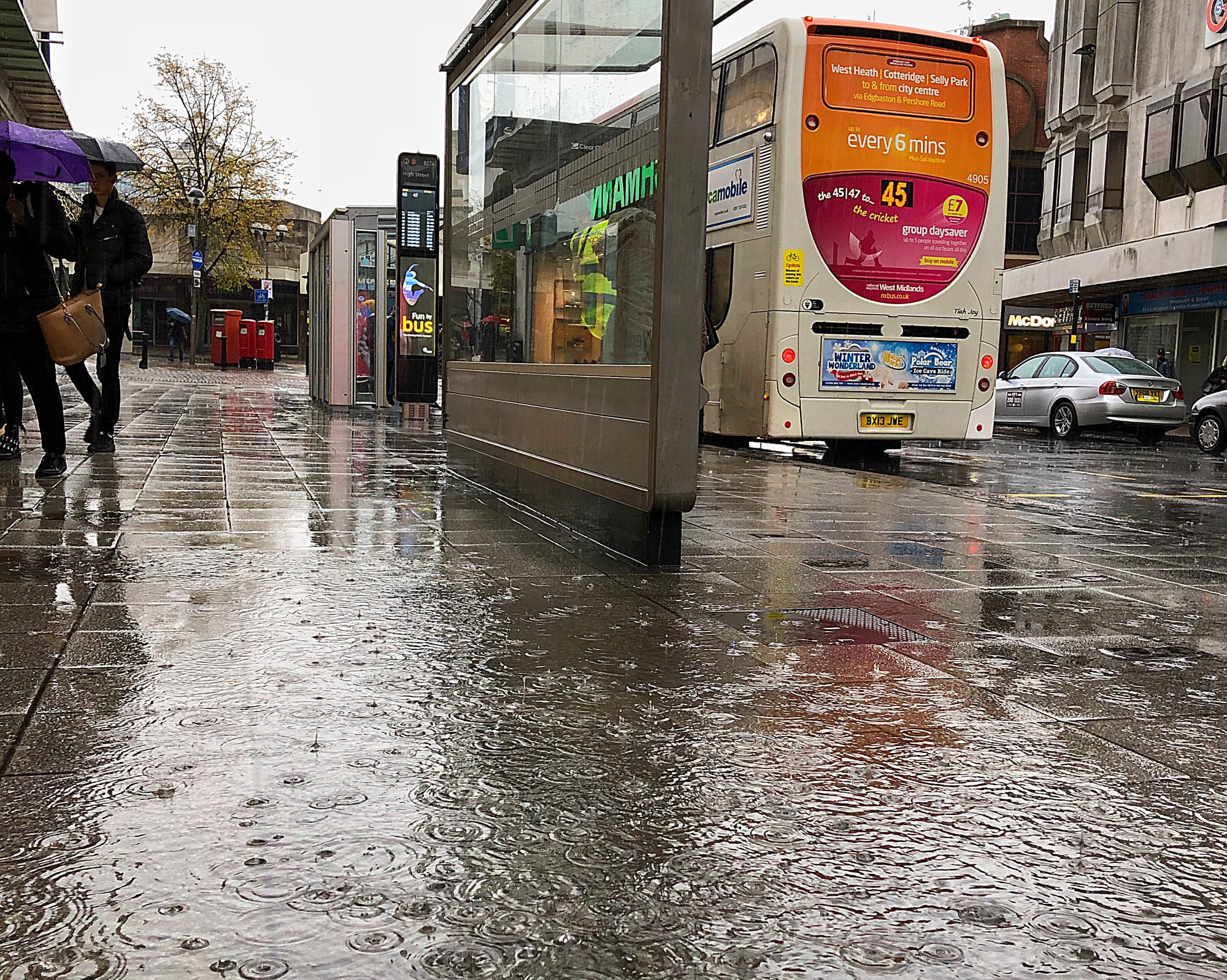
The waiting becomes part of the work, and in so doing, every part of life becomes hard. This is what ages people, makes them ill, gives them walking sticks. The conditions in which we wait matter, not least because the people who do the most waiting for the buses that never come tend to be either very old or very young, tend to be women, are more likely to be people of colour (which makes waiting less safe), and are likely to be variously penalised for having their time stolen in this way. When we are told we must not wait, that time is money, what does it say about our notions of social worth when people are forced to wait anyway? So if you ask me what motivates me to write about buses – why I think they’re worth paying close attention to – it’s that so little attention is paid to the significance they have for people who have no other means of getting around. The quality of their commute is their quality of life.
Later, my dad at last safe in the arms of the NHS, I walked the mile or two back to the hospital exit, where outside it was now dark and raining heavily. I negotiated the car park and the relentless flow of minicabs, to get back to the bus shelter crowded with tired hospital staff on their phones, pulling themselves and their wet coats over the damp threshold of the 97 when it finally came. Everyone was silent. I collapsed into a seat, on the top deck again, and focused on the sound of the windscreen wipers, the thought of being warm and dry again, against the retching of the aged diesel engine dragging us home.
A couple of days later, I did the whole trip again: the bus from my home to the station, the train to Birmingham, and the 97 out from town to the hospital. I was coming to collect my dad, who had been deemed ready to be discharged back into the world.
As we approached the automatic doors, he patted his pockets and asked, “Have you got my bus pass?”
All donations go towards supporting the Bee’s mission to nurture, publish promote and pay for the best new working-class writing.


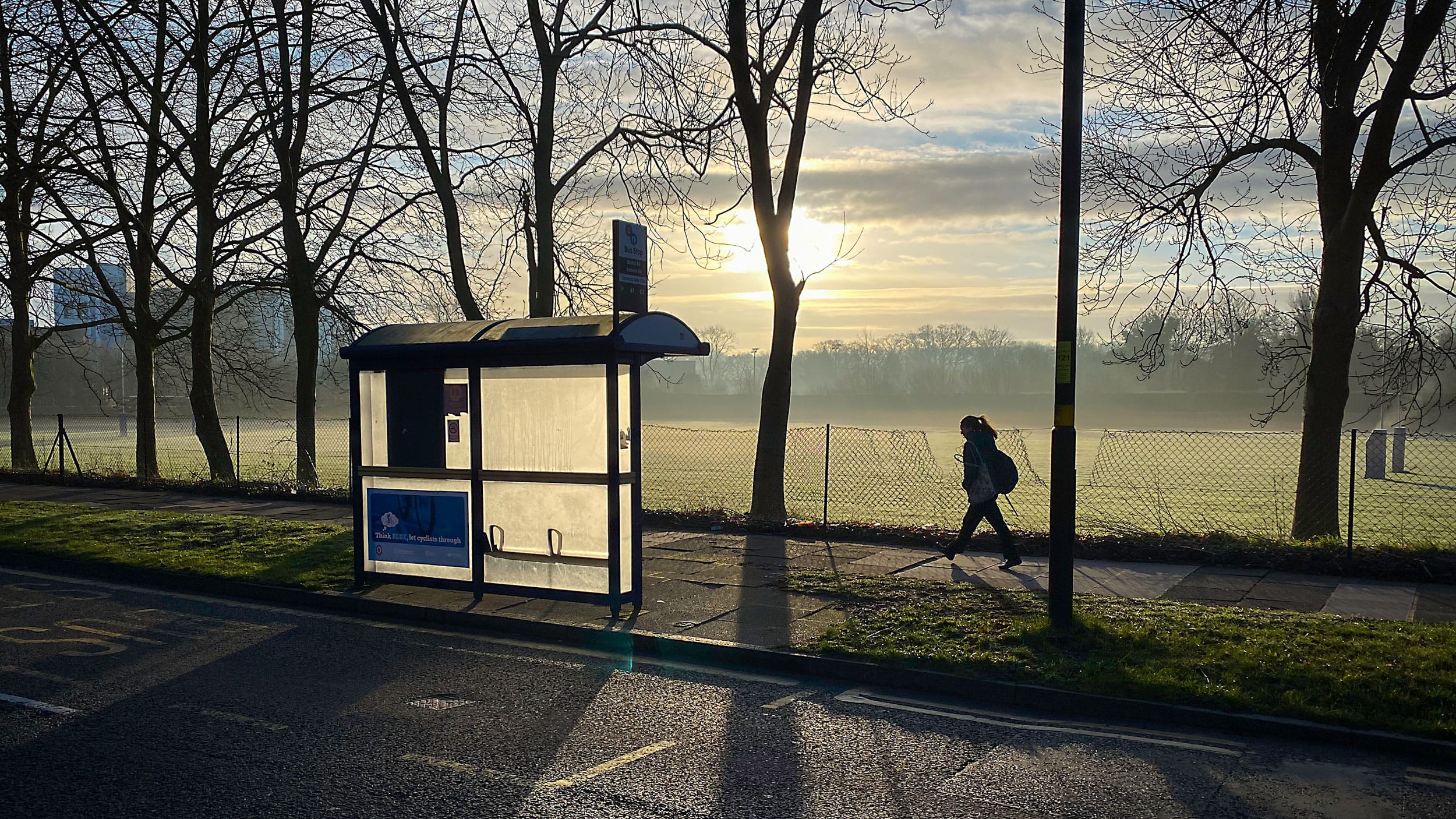

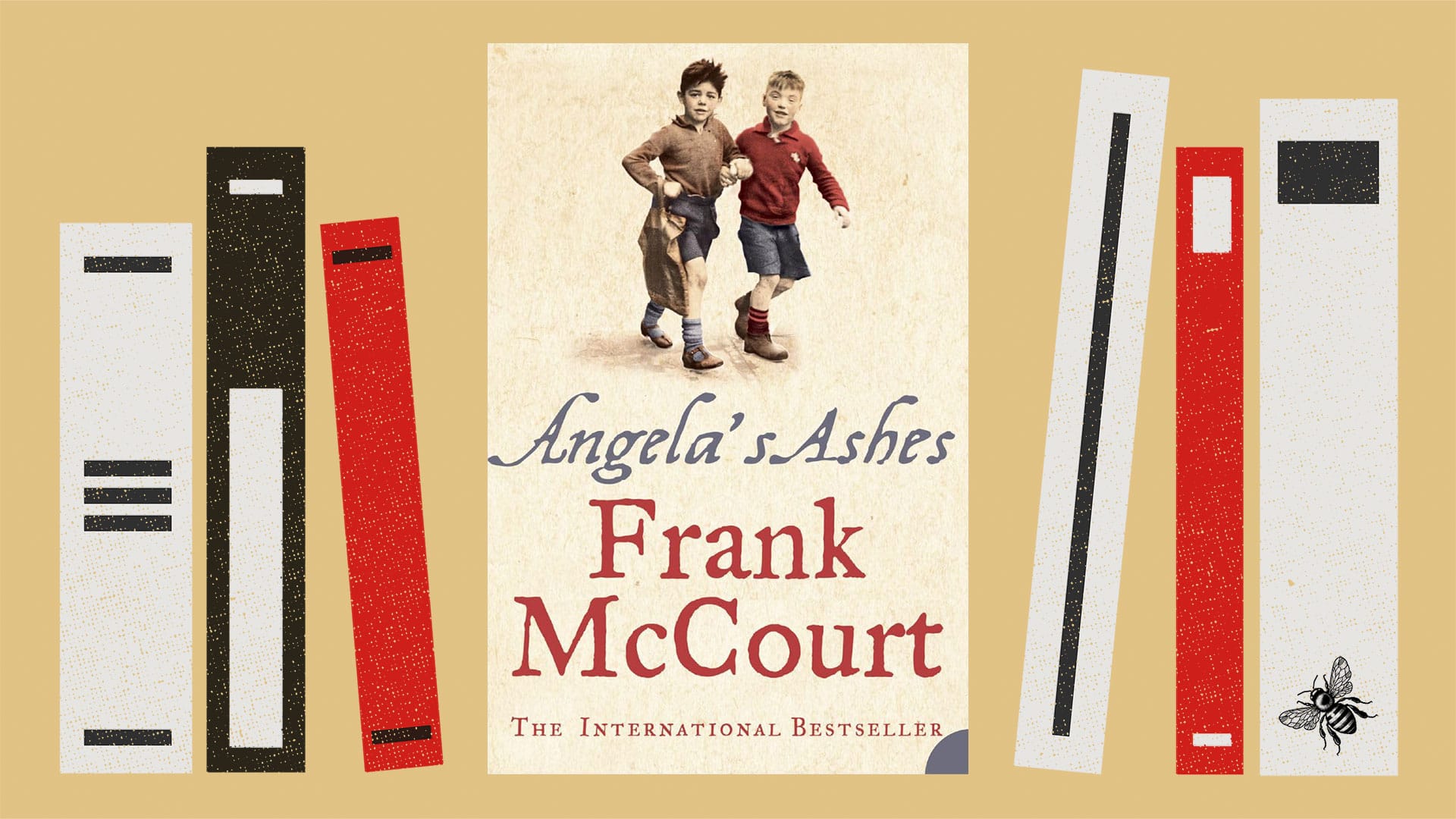
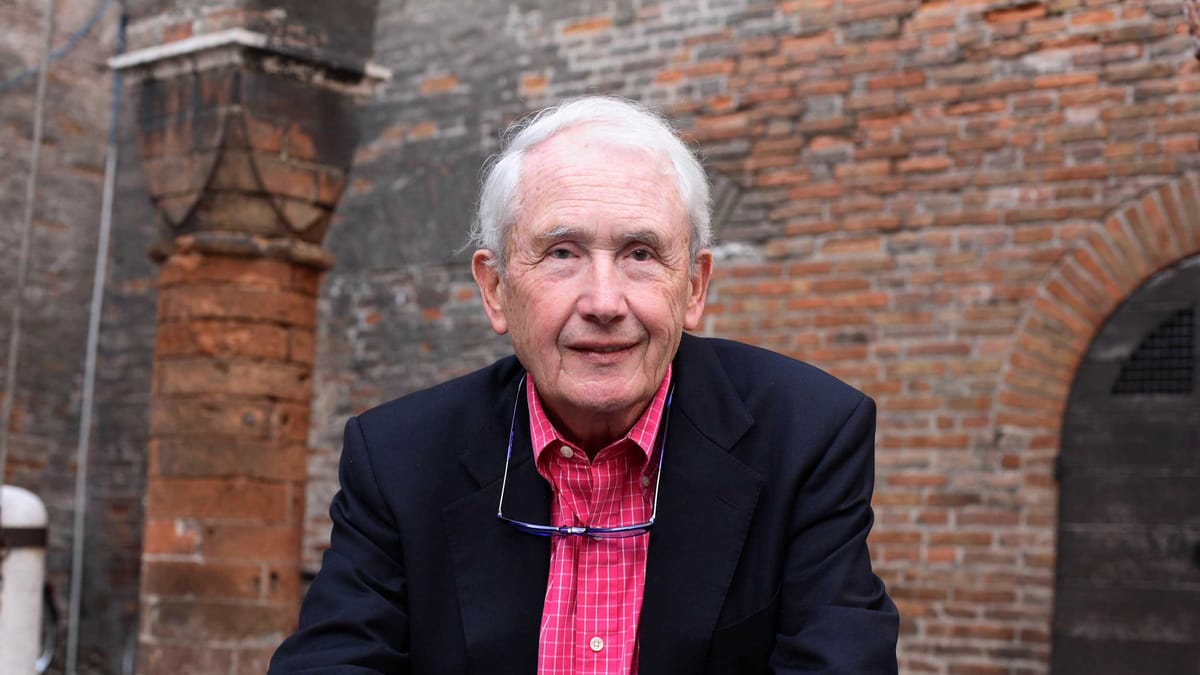
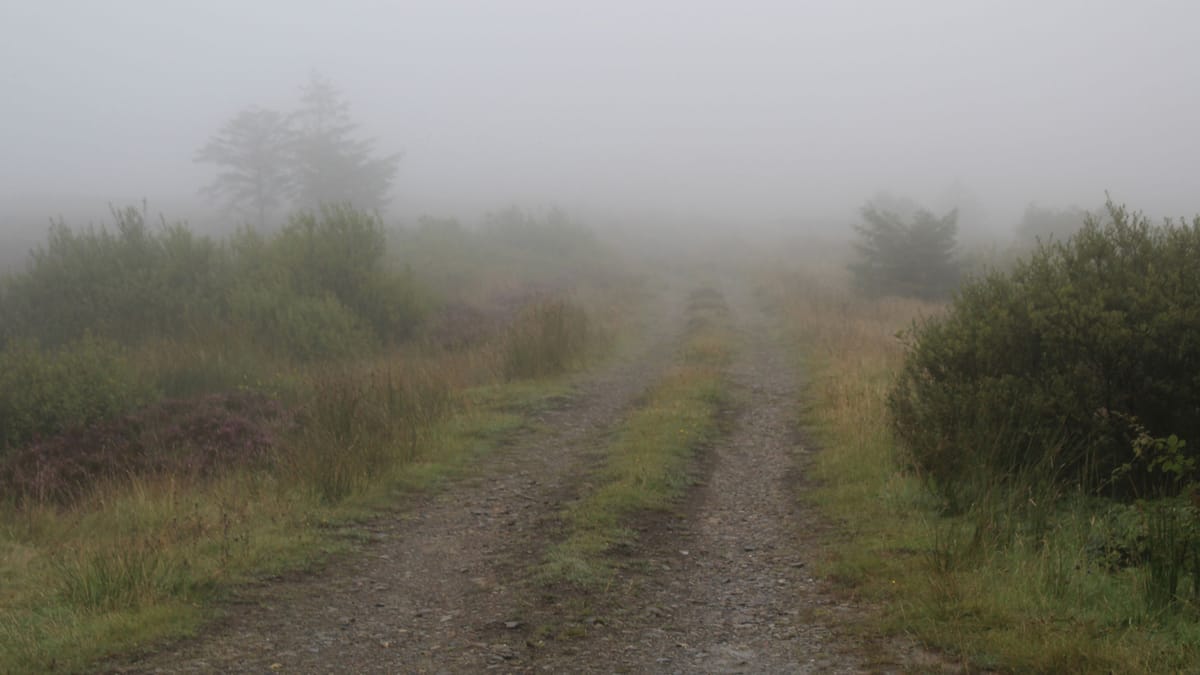


Comments